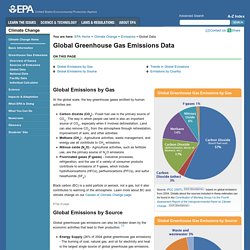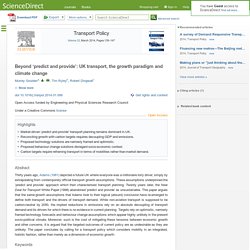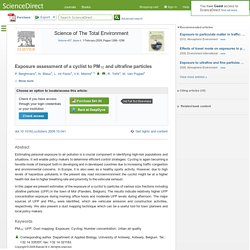

Global Emissions. Global Emissions by Gas At the global scale, the key greenhouse gases emitted by human activities are: Carbon dioxide (CO2) - Fossil fuel use is the primary source of CO2.

The way in which people use land is also an important source of CO2, especially when it involves deforestation. Land can also remove CO2 from the atmosphere through reforestation, improvement of soils, and other activities. Methane (CH4) - Agricultural activities, waste management, and energy use all contribute to CH4 emissions. Black carbon (BC) is a solid particle or aerosol, not a gas, but it also contributes to warming of the atmosphere. Top of page Global Emissions by Source Global greenhouse gas emissions can also be broken down by the economic activities that lead to their production. [1] Energy Supply (26% of 2004 global greenhouse gas emissions) - The burning of coal, natural gas, and oil for electricity and heat is the largest single source of global greenhouse gas emissions. Trends in Global Emissions 1. Sustainable Transport in China. Sustainable transport. Sustainable transport refers to the broad subject of transport that is or approaches being sustainable.

It includes vehicles, energy, infrastructure, roads, railways, airways, waterways, canals, pipelines, and terminals. Transport operations and logistics as well as transit-oriented development are involved. Transportation sustainability is largely being measured by transportation system effectiveness and efficiency as well as the environmental impacts of the system.[1] Short-term activity often promotes incremental improvement in fuel efficiency and vehicle emissions controls while long-term goals include migrating transportation from fossil-based energy to other alternatives such as renewable energy and use of other renewable resources.
The entire life cycle of transport systems is subject to sustainability measurement and optimization.[2] Sustainable transport systems make a positive contribution to the environmental, social and economic sustainability of the communities they serve. HS2: this environmental report should be the final blow. How many more punches can the government's battered HS2 project absorb before the final knockout blow is delivered?

The House of Commons public accounts committee has already given it the thumbs down. So has the National Audit Office. The transport secretary, Patrick McLoughlin, ironically used the Freedom of Information Act to veto publication of an HS2 review by the cabinet office's Major Projects Authority, presumably because he didn't like what it said. Now the Commons environmental audit committee has produced a devastating critique of the scheme's environmental aspects. The proposal to establish "a high-speed rail network" appears in the environment section of the coalition agreement, published on 12 May 2010.
As far as HS2's contribution to the reductions in CO2 emissions is concerned, the committee concludes: "There is some debate about whether HS2 will deliver a reduction in emissions by taking travellers off the roads and planes. Beyond ‘predict and provide’: UK transport, the growth paradigm and climate change. <div class="msgBox" style="margin-top:10px;"><span class="errMsg"><div>JavaScript is disabled on your browser.

Please enable JavaScript to use all the features on this page. </div></span></div><br /> A post-carbon aviation future: Airports and the transition to a cleaner aviation sector. A Graduate College of Management, Southern Cross University, Tweed Gold Coast, Australiab Pro Vice-Chancellor (Research), Southern Cross University, Tweed Gold Coast, Australia Available online 10 November 2009 Choose an option to locate/access this article: Check if you have access through your login credentials or your institution Check access doi:10.1016/j.futures.2009.11.005 Get rights and content There is an increasing global interest in sustainable aviation technologies as a result of concerns associated with the carbon-intensive nature of the industry and the imminence of reaching peak oil.

Copyright © 2009 Elsevier Ltd. Locarbtransport_final_19_11. Exposure assessment of a cyclist to PM10 and ultrafine particles. A VITO, Flemish Institute for Technological Research Boeretang 200, B-2400 Mol, Belgiumb Department of Bioscience Engineering, University of Antwerp, Antwerp, Belgium Received 24 June 2008, Revised 13 October 2008, Accepted 16 October 2008, Available online 25 November 2008 Choose an option to locate/access this article: Check if you have access through your login credentials or your institution Check access doi:10.1016/j.scitotenv.2008.10.041 Get rights and content Abstract Estimating personal exposure to air pollution is a crucial component in identifying high-risk populations and situations.

In this paper we present estimates of the exposure of a cyclist to particles of various size fractions including ultrafine particles (UFP) in the town of Mol (Flanders, Belgium). Keywords. Change your travel for the environment. Travelling in an environment with no congestion or air pollution may seem like a far-fetched desire.

However, it’s possible for us all to make changes to the way we travel and contribute to a cleaner, greener environment. Sadly, there is no longer any serious scientific doubt that global climate change is upon us. We all contribute to this in many different ways every day – from keeping our homes warm and feeding ourselves to the things we consume, and of course, the way we travel.